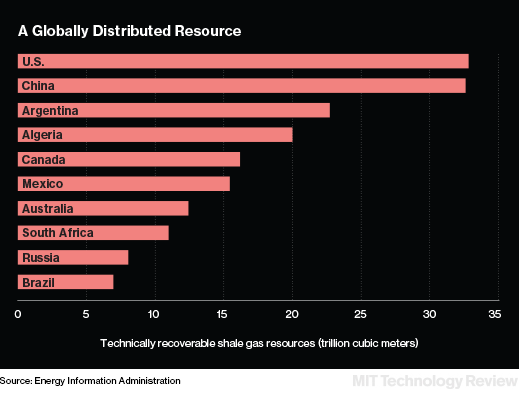Where Is the Global Shale Gas Revolution?
The United States is not alone in having massive shale gas resources: shale formations rich in gas can be found all over the world. But so far no other country has come close to replicating the U.S. boom that has led to relatively cheap natural gas and helped curb yearly carbon dioxide emissions.
According to recent numbers from the U.S. Energy Information Administration, only two other countries—Canada and China—are now producing commercial volumes of gas from shale formations, a process made feasible relatively recently thanks to the development of hydraulic fracturing and horizontal drilling technology (see “Natural Gas Changes the Energy Map”).
Those countries lag far behind the United States in production, however. Though China, the world’s largest annual emitter of carbon dioxide, has nearly as much technically recoverable shale gas as the U.S. according to recent EIA estimates, challenging geology has been a major obstacle, and the country has had to scale back its near-term goals dramatically (see “China’s Shale Gas Bust”).

According to the EIA, recent developments indicate that China is on schedule to produce some 17 million cubic meters per day by the end of this year. By comparison, current U.S. production is roughly 1.3 billion cubic meters per day. Canada, the second-largest shale gas producer, produced roughly 113 million cubic meters per day last year.
Mexico has begun to produce a very small amount of the gas, and Poland, Algeria, Australia, Colombia, and Russia are all exploring the potential for developing oil and gas resources from their own shale formations. But according to the EIA, the “logistics and infrastructure” necessary to support production at the level seen in the United States does not yet exist in other countries besides Canada and China.
Keep Reading
Most Popular
Large language models can do jaw-dropping things. But nobody knows exactly why.
And that's a problem. Figuring it out is one of the biggest scientific puzzles of our time and a crucial step towards controlling more powerful future models.
The problem with plug-in hybrids? Their drivers.
Plug-in hybrids are often sold as a transition to EVs, but new data from Europe shows we’re still underestimating the emissions they produce.
Google DeepMind’s new generative model makes Super Mario–like games from scratch
Genie learns how to control games by watching hours and hours of video. It could help train next-gen robots too.
How scientists traced a mysterious covid case back to six toilets
When wastewater surveillance turns into a hunt for a single infected individual, the ethics get tricky.
Stay connected
Get the latest updates from
MIT Technology Review
Discover special offers, top stories, upcoming events, and more.